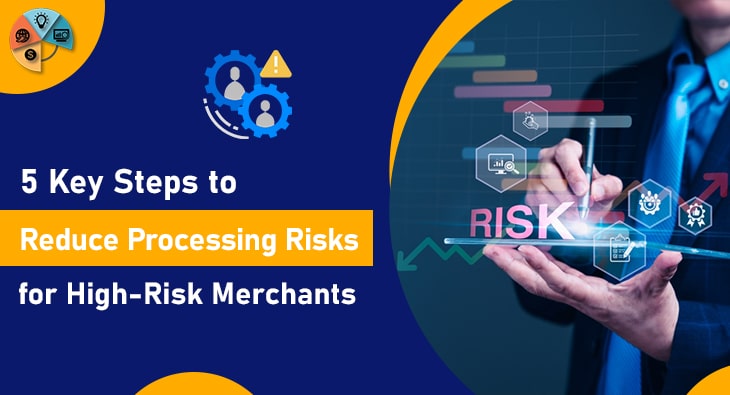Comprehending Processing Risks
Processing risks encompass the potential challenges and uncertainties businesses face when handling transactions. These risks can lead to financial losses, reputational damage, and operational disruptions. For high-risk merchants, such challenges are heightened due to the nature of their industries, making them more susceptible to fraud, chargebacks, and compliance issues.
A deep understanding of these risks is essential for effective management. By pinpointing the specific processing risks relevant to your business, you can devise targeted strategies to mitigate them. This involves thorough analysis of transaction data, gaining insights into customer behavior, and identifying patterns that may signal potential problems.
For high-risk merchants, being proactive in recognizing these risks is crucial. It requires not just an understanding of the broader landscape but also a keen eye for detail. Transaction data analysis can reveal valuable information, such as frequent chargeback sources or unusual transaction patterns, allowing businesses to take preemptive measures.
Recognizing customer behavior is another key component. By understanding how your customers interact with your business, you can identify anomalies that may indicate fraudulent activities. This enables you to implement security measures tailored to your specific needs, reducing the likelihood of financial loss and reputational harm.
In addition, awareness of compliance issues is vital. high-risk merchants must stay updated on industry regulations and ensure they meet all necessary standards. Non-compliance can result in severe penalties, making it imperative to stay informed and proactive.
Overall, a comprehensive approach to understanding processing risks involves detailed analysis, proactive measures, and constant vigilance. high-risk merchants must leverage data and insights to create robust risk management plans, ensuring they are prepared to address any challenges that arise.
Some Related Blogs
- Emerging Payment Solutions and What They Mean for Merchants
- How to Choose the Right Payment Processor for Your Business Model
- Case Studies of Successful Payment Implementations
- The Importance of Payment Integration with Accounting Systems
Recognizing High-Risk Elements
Various factors can classify a business as high-risk, which include industry type, transaction volume, average transaction size, and geographical location. Common high-risk industries encompass online gambling, travel, adult entertainment, and pharmaceuticals. These sectors frequently encounter higher rates of chargebacks and fraud, causing payment processors to exercise greater caution when partnering with them.
The influence of these high-risk elements on payment processing can be substantial. Businesses with a high chargeback ratio may face increased scrutiny from banks and payment processors, which can lead to higher fees or even the termination of their merchant accounts. Additionally, companies in high-risk industries often find fewer payment processing solutions available to them. This makes it crucial for merchants to identify and collaborate with reliable providers who understand their unique challenges.
Choosing the right payment processor is vital for high-risk merchants. Look for processors experienced in handling high-risk transactions, as they typically offer specialized services and security measures tailored to your industry’s specific needs. Advanced fraud detection tools and risk management strategies provided by these processors can help mitigate some of the inherent risks.
Understanding the specific high-risk elements that apply to your business can help you develop targeted strategies to manage them. For example, merchants in the travel industry might focus on securing reservations with more stringent verification processes, while those in adult entertainment could implement enhanced age and identity checks.
By addressing these high-risk elements head-on, businesses can not only reduce processing risks but also build stronger relationships with payment processors and financial institutions. This proactive approach helps in maintaining smoother operations and safeguarding against potential disruptions.
Enhancing Payment Processing Systems
Optimizing your payment processing system is crucial for minimizing processing risks. Begin by selecting a payment gateway experienced in handling high-risk transactions, as these gateways are equipped with advanced security measures designed to protect against fraud and data breaches. Look for features such as multi-layered encryption, tokenization, and secure socket layer (SSL) technology to keep sensitive customer information safe.

In addition to selecting a specialized gateway, integrate automated tools for managing chargebacks and monitoring transactions in real time. Automated chargeback management systems can help you quickly identify and resolve disputes, reducing the financial impact on your business. Real-time transaction monitoring provides instant alerts for suspicious activities, enabling you to take immediate action against potential threats.
Another essential aspect is the implementation of multi-factor authentication (MFA) to add an extra layer of security. MFA requires users to provide two or more verification factors to gain access, making it more difficult for unauthorized individuals to infiltrate your payment system. This can significantly reduce the risk of fraud and unauthorized transactions.
Collaborate with payment processors that offer robust fraud detection tools. These tools use machine learning and artificial intelligence to analyze transaction data, identify unusual patterns, and flag potentially fraudulent activities. By leveraging these technologies, you can stay ahead of emerging threats and protect your business from financial loss.
Lastly, ensure that your payment processing system is scalable and adaptable to accommodate growth and changes in your business model. This flexibility allows you to implement new security features and adapt to evolving industry standards and regulations, keeping your transactions secure and your business compliant. Regularly updating your system and training staff on best practices can further enhance the security and efficiency of your payment processing operations.
Ongoing Monitoring and Adherence
Continuous vigilance is imperative for high-risk merchants to manage processing risks effectively. Implementing systems that deliver real-time alerts for suspicious activities allows immediate response to potential threats, preventing issues before they escalate. Regular transaction data reviews are essential to spot trends and patterns indicative of emerging risks, aiding in proactive measures to safeguard your business.
Maintaining compliance with industry regulations, such as the Payment Card Industry Data Security Standard (PCI DSS), is equally important. Adhering to these standards protects cardholder information and ensures secure transactions. Non-compliance can lead to significant penalties and legal issues, making it crucial to stay updated on regulatory changes and integrate necessary adjustments promptly.
Additionally, fostering a culture of security awareness within your organization is beneficial. Regularly training employees on best practices and emerging threats can enhance overall security and operational efficiency. By combining real-time monitoring, regulatory adherence, and ongoing education, high-risk merchants can significantly mitigate processing risks and maintain smoother operations.
![]()
Email us anytime!
Email customer service 24/7
![]()
Call us anytime!
Reach customer care 24/7 at +1 (727) 330-3944



5 thoughts on “5 Key Steps to Reduce Processing Risks for High-Risk Merchants”
Comments are closed.